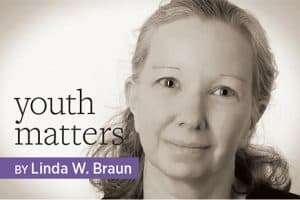
More and more, library staffers across the US are using an equity lens to evaluate and reimagine the programs and services they provide for and with their communities. Libraries have revamped everything from borrowing policies and building hours to job descriptions and outreach efforts to better meet the needs of marginalized groups.
Sometimes when patrons learn their library will take an equity approach to programs and services, they wonder, “What is going to happen to everything that I love about the library?” In anticipation of this question, equity consultant LaKesha Kimbrough suggested that the planning team for the California Library Association’s Building Equity-Based Summers (BEBS) initiative, of which I am a part, talk about targeted universalism.
A framework developed by the Haas Institute for a Fair and Inclusive Society at University of California, Berkeley, targeted universalism aims for better policy outcomes for marginalized groups. According to the institute, targeted universalism involves setting universal goals with everyone in mind but achieving them with processes tailored to how different groups are situated within structures, within cultures, and across geographies.
San Diego Public Library’s (SDPL) social equity policy reflects this framework. In 2019, SDPL decided that branches less likely to secure private donations should receive a higher allocation of city funds. This plan recognizes that less-endowed branches are often in neighborhoods that could benefit more from library services; it doesn’t mean other branches don’t receive adequate funding, just that a higher share of funds already comes from the community.
Targeted universalism aims for better policy outcomes for marginalized groups.
Targeted universalism doesn’t need to be implemented on a large scale to be effective. When we connect with the people we seek to serve, we learn what support they need, what their barriers are, and what meeting a goal would look like for them. “We are all working together to get to the same place,” Kimbrough says.
What does using targeted universalism look like when working toward mutual goals in youth services? The BEBS project, which is supported by the Institute of Museum and Library Services and administered by the California State Library, provides some insights:
Identify stakeholders. We determined that staffers must look beyond traditional programming partners, such as schools and parks and recreation departments, and consider minority-owned businesses, faith-based organizations, and community-led organizations. Equity goals cannot be accomplished without partnering with stakeholders who live in and work with marginalized communities.
Learn with and from your communities. What are the strengths of and challenges faced by the groups we would like to serve more effectively? For instance, our project researched what summers are like for marginalized families and where they spend their time during those months. Look at people and groups as unique individuals and communities by disaggregating the data you collect.
Consider barriers to targeted strategies. Determine the systemic and structural challenges your staffers and stakeholders may face, and anticipate how to move beyond them. In our project, staffers tried to resolve roadblocks that had prevented partnerships with minority-owned businesses by bringing their observations to library leaders and community members.
Develop varied approaches. Acknowledge that to achieve your goal, you may end up designing and implementing different services for multiple and diverse populations. One participating staffer reimagined summer program registration to allow those in communities that don’t often participate in these programs an early registration period and different ways to sign up.
When library staffers adopt a targeted approach, users will come to realize that there is not a loss in services and that equity-based adjustments do not result in any one group receiving less. Instead, they will see that everyone gets what they need in a way that best suits the individual or community.

